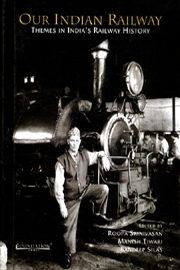Book contents
- Frontmatter
- Contents
- Foreword
- Preface
- Introduction
- 1 The Colonial Context of the Bengal Renaissance: A Note on Early Railway–Thinking in Bengal
- 2 Minute by Dalhousie on Introduction of Railways in India, as Submitted to the Court of Directors, 4 July 1850
- 3 Ackworth Committee Report
- 4 Competition and Adaptation: The Operation of Railways in Northern India: Uttar Pradesh 1860–1914
- 5 Economic Nationalism and the Railway Debate, circa 1880-1905
- 6 Railway Policing and Security in Colonial India, c. 1860–1930
- 7 Indian Nationalism and Railways
- 8 The Railway in Colonial India: Between Ideas and Impacts
- 9 The Dark Side of the Force: Mistakes, Mismanagement and the Malfeasance in Early Railways of the British Indian Empire
- 10 Tunnels and Bridges: Railways, Narrative and Power in two Novels of India
- 11 A View of the History of Indian Railways
- 12 The Romance of Steam
- Index
- Plate section
Foreword
Published online by Cambridge University Press: 26 October 2011
- Frontmatter
- Contents
- Foreword
- Preface
- Introduction
- 1 The Colonial Context of the Bengal Renaissance: A Note on Early Railway–Thinking in Bengal
- 2 Minute by Dalhousie on Introduction of Railways in India, as Submitted to the Court of Directors, 4 July 1850
- 3 Ackworth Committee Report
- 4 Competition and Adaptation: The Operation of Railways in Northern India: Uttar Pradesh 1860–1914
- 5 Economic Nationalism and the Railway Debate, circa 1880-1905
- 6 Railway Policing and Security in Colonial India, c. 1860–1930
- 7 Indian Nationalism and Railways
- 8 The Railway in Colonial India: Between Ideas and Impacts
- 9 The Dark Side of the Force: Mistakes, Mismanagement and the Malfeasance in Early Railways of the British Indian Empire
- 10 Tunnels and Bridges: Railways, Narrative and Power in two Novels of India
- 11 A View of the History of Indian Railways
- 12 The Romance of Steam
- Index
- Plate section
Summary
I am delighted that the Directorate of Public Relations of the Railway Board has brought out a book on the themes and issues relating to Railway's long history in India over 150 years.
The Railways in India have had the good fortune to develop from a small company in 1853 to one of the largest organizations in the world. We can proudly say that Railways in India have grown many times bigger than even the vision of its founders. The actions of the then railway companies in England, who then brought in ‘the wheel’ to spin more profits for them in India, soon led to many socio-economic and political spin-offs.
In its long journey, public aspirations kept blending with the evolvement of railways in India. The railway companies, after their initial wave of expansion, gave attention to the modernization of the railway locomotives and the coaching stock. However, there was considerable independence in choosing the gauge, be it narrow gauge, meter gauge or broad gauge. Therefore, we had a functional blend of different gauges in the country at the time of independence and for decades thereafter, till we decided to improve our operations and adopt the policy of uni-gauge. Today, the railways in India have grown into a colossal organization, which is not only sustaining the economy but also strengthening the social fabric of the country.
- Type
- Chapter
- Information
- Our Indian RailwayThemes in India's Railway History, pp. vii - viiiPublisher: Foundation BooksPrint publication year: 2006



